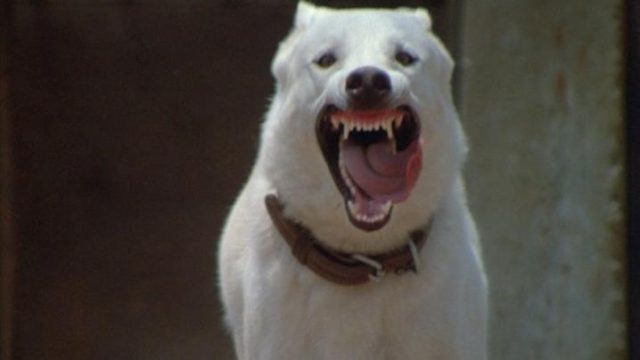A dog trained to attack black people.
If one knows nothing about White Dog except its explosive premise, it’s easy to see how such a movie could go wrong. And that’s exactly what associations such as the NAACP (National Association for the Advancement of Colored People) saw during the production of the movie in 1982: they threatened to boycott the film without even having seen the final result, accusing it of being racist. As a result, Paramount buried the movie’s release, showing it briefly in limited screenings in the USA before shelving it. The studio’s actions hurt the director, Samuel Fuller, so much, that he moved to France soon after – making this his final movie in the United States.
And White Dog is a fiercely anti-racist film. For instance, it’s perfectly clear who the hero of the movie is: Keys (Paul Winfield), the African-American animal trainer who insists on “deprogramming” the white dog from the title. Even though he has failed twice in the past, Keys insists that there’s a chance of removing the evil from the dog. “With that dog out of circulation, there’ll be a lot of people sleeping better at night”, remarks Carruthers (Burl Ives), Keys’s business partner. At one point, even Julie (Kristy McNichol), the woman who found the dog and sides with Keys, gives up and agrees that the dog should be put to sleep. But Keys insists that killing the dog is not the solution. The animal needs to be reeducated.
Because that’s the message of the film: racism is an illness. And as with all illnesses, we should try to cure it. But it’s an illness brought about by learned behavior, and therefore it can only be cured with counter-behavior. Education. Training. Like the patient way Keys daily trains the dog to trust him (and eventually other black people).
White Dog might be considered a B-movie (there’s a clunky and inorganic scene early in the film involving a man attacking Julie), but the talent involved in it is A+. Fuller, know for gritty noirs such as The Naked Kiss, moves his camera with energy and vitality. When Julie is confronted with the only truly evil character in the entire film, the camera reveals his face with the surprise of a horror movie. And the dog’s ferocious snarl, captured in terrifying slow motion, becomes the perfect (and unforgettable) image for the horrors of racism: it’s irrational, it’s dangerous, it’s deadly.
Paul Winfield brings an enormous amount of dignity and resolution to the role of Keys – of the three main characters, he’s the one who suffered the most and yet the fiercest believer in change for the better. Such belief was shared by Fuller: in the book that originated the film, Keys ends up training the dog to attack white people. But Fuller fought for a different ending, one that would remove the racism from the dog’s behavior (clashing with his co-screenwriter, Curtis Hanson, who wanted to keep the original ending). In the end, both screenwriters managed to find a solution even more pessimistic and heartbreaking.

